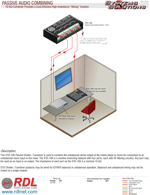
AN-2200
Description:
The STD-10K Passive Divider / Combiner is used to combine the unbalanced stereo output of the media player to mono for connection to an unbalanced mono input on the mixer. The STD-10K is a resistive branching network with four ports, each with RF filtering circuitry. Any port may be used as an input or an output. The impedance of each port on the STD-10K is a nominal 10 kΩ. STD Divider / Combiner products may be wired for EITHER balanced or unbalanced operation. Balanced and unbalanced wiring may not be mixed on a single module.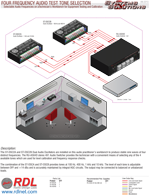
FOUR FREQUENCY AUDIO TEST TONE SELECTION
Selectable Audio Frequencies on aTechnician’s Workbench for Equipment Testing and Calibration
AN-2213
Description:
The ST-OSC2A and ST-OSC2B Dual Audio Oscillators are installed on this audio practitioner’s workbench to produce stable sine waves at four distinct frequencies. The RU-ASX4D stereo 4X1 Audio Switcher provides the technician with a convenient means of selecting any of the 4 available tones which are used for level calibration and frequency response checks. The combination of the ST-OSCA and ST-OSCB provides tones at 100 Hz, 400 Hz, 1 kHz and 10 kHz. The level of each tone is adjustable between OFF and +14 dBu and is accurately maintained by integral AGC circuits. The output may be connected to balanced or unbalanced loads.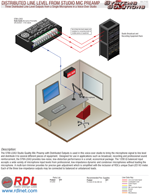
DISTRIBUTED LINE LEVEL FROM STUDIO MIC PREAMP
Three Distributed Line-Level Outputs from a Single Microphone in a Voice-Over Studio
AN-2183
Description:
The STM-LDA3 Studio Quality Mic Preamp with Distributed Outputs is used in this voice-over studio to bring the microphone signal to line level and distribute it to several different pieces of equipment. Designed for use in applications such as broadcast, recording and professional sound reinforcement, the STM-LDA3 provides low-noise, low-distortion performance in a small, economical package. The 1200 Ω balanced input accepts a wide variety of microphone input levels from professional, low-impedance dynamic and condenser microphones without loading the microphone. A multi-turn trimmer provides for precise gain adjustment which is simplified with th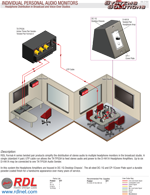
AN-2164
Description:
RDL Format-A series twisted pair products simplify the distribution of stereo audio to multiple headphone monitors in the broadcast studio. A single (standard 4 pair) UTP cable run allows the TX-TPS3A to feed stereo audio and power to the D-HA1A Headphone Amplifiers. Up to six D-HA1A may be connected to one TX-TPS3A Audio Sender. In this system the Headphone Amplifiers are housed in DC-1G Desktop Chassis’. The all-steel DC-1G and CP-1Cover Plate sport a durable powder-coated finish for a handsome appearance over many years of service.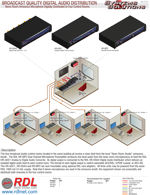
BROADCAST QUALITY DIGITAL AUDIO DISTRIBUTION
News Room Announce Microphone Digitally Distributed to Four Control Rooms
AN-2151
Description:
The four broadcast studio control rooms located in the same building all receive a news feed from the local “News Room Studio” announce booth. The RDL HR-MP2 Dual Channel Microphone Preamplifier produces line-level audio from the news room microphone(s) to feed the RDL HR-ADC1 Analog to Digital Audio Converter. Its digital output is connected to the RDL HR-DDA4 Digital Audio Distributor which delivers an isolated digital audio feed to each control room. The format of each digital output is switch-selectable AES/EBU, S/PDIF coaxial, or AES-3ID. The HR-ADC1, HR-DDA4 and HR-MP2 are rack mountable using optional RDL rack adapters. All three units may be powered from the same RDL 1000 mA 24 Vdc supply. Note that if stereo microphones are used in the announce booth, the equipment shown can preamplify and distribute both channels to the four control rooms.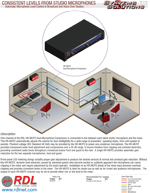
CONSISTENT LEVELS FROM STUDIO MICROPHONES
Automatic Microphone Level Control in Broadcast and Voice-Over Studios
AN-2148
Description:
One channel of the RDL HR-MCP2 Dual Microphone Compressor is connected in-line between each talent studio microphone and the mixer. The HR-MCP2 automatically adjusts the volume for best intelligibility for a wide range of presenters’ speaking styles, from soft-spoken to excited. Phantom voltage (IEC Standard 48 Volt) may be provided by the HR-MCP2 to power any condenser microphone. The HR-MCP2 provides transparent audio level adjustment and compression over a 25 dB range. It insures freedom from clipping and overload distortion, providing consistent audio levels throughout a broadcast and/or from one guest to the next. A single HR-MCP2 provides automatic gain reduction for the two separate microphones, host and guest. Front-panel LED metering strings simplify proper gain adjustment to produce the desired amount of normal and overload gain reduction. Without the HR-MCP2, dynamic level extremes caused by untrained guests who become excited or suddenly approach the microphone can cause clipping in the mixer and require adjustment by the board operator. Installation of an HR-MCP2 ahead of the mixer input prevents overload clipping and provides consistent levels to the mixer. The HR-MCP2 is ideal for studio use as well as for crowd and audience microphones. The output of each HR-MCP2 channel may be set to provide either mic or line level to the mixer.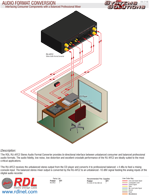
Description:
The RDL RU-AFC2 Stereo Audio Format Converter provides bi-directional interface between unbalanced consumer and balanced professional audio formats. The audio fidelity, low noise, low distortion and excellent crosstalk performance of the RU AFC2 are ideally suited to the most critical applications. The RU-AFC2 receives the unbalanced stereo output from the CD player and converts it to professional balanced +4 dBu to feed a mixing console input. The balanced stereo mixer output is converted by the RU-AFC2 to an unbalanced -10 dBV signal feeding the analog inputs of the digital audio recorder.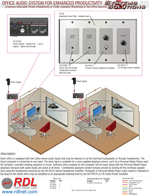
OFFICE AUDIO SYSTEM FOR ENHANCED PRODUCTIVITY
Employee-Selectable Private (Headphone) or Public (Speaker) Monitoring of Two Office Sources
AN-2170
Description:
Each office is equipped with two active stereo audio inputs that may be listened to via the overhead loudspeaker or through headphones. The local computer is connected to one input. The other input is available for a user-supplied playback device, such as a Personal Media Player used for dictation, recorded meeting playback or music. Software alerts enabled on the computer will be heard along with the Personal Media Player playback because both audio inputs are active at all times. Confidential playback content remains private by turning off the overhead speaker and using the headphones powered by the DS-HA1A Stereo Headphone Amplifier. Computer or Personal Media Player audio suited or intended to be heard in the whole office may be amplified to an appropriate listening level by the DS-TPA1A 3.5 W Audio Power Amplifier.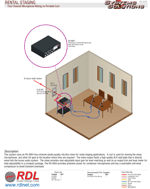
Description:
This system uses an RU-MX4 four-channel studio-quality mic/line mixer for rental staging applications. A cart is used for moving the mixer, microphones, and other AV gear to the location where they are required. The mixer output feeds a high quality XLR wall plate that is directly wired into the house audio system. The mixer provides user-adjustable input gain for level matching as well as an output trim and level meter for total adjustability in a compact package. The RU-MX4 provides phantom power for condenser microphones and has a switchable soft-knee compressor to avoid transient overloads.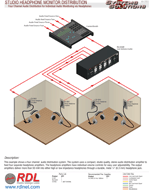
STUDIO HEADPHONE MONITOR DISTRIBUTION
Four Channel Audio Distribution for Individual Audio Monitoring via Headphones
AN-2053
Description:
This example shows a four channel audio distribution system. The system uses a compact, studio quality, stereo audio distribution amplifier to feed four separate headphone amplifiers. The headphone amplifiers have individual volume controls for easy user adjustablility. The output amplifiers deliver more than 50 mW into either high or low impedance headphones through a durable, metal ¼” (6.3 mm) headphone jack.